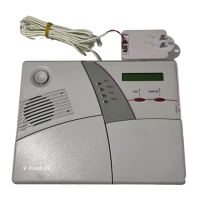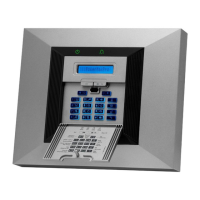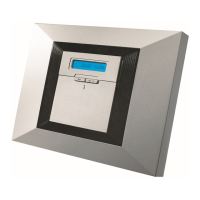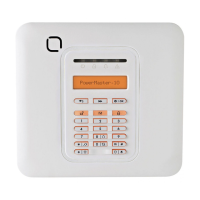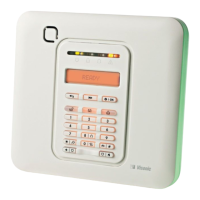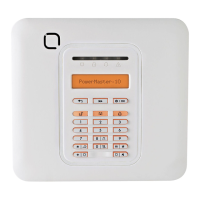24 D-303983 PowerMaxComplete Installer's Guide
Ambient Level [Fig 4.5.3(24d)]
Here you select the ambient noise level of the installation.
If it is a relatively noisy environment, set it to High (default
setting). If it is a very quiet environment, set to Low.
The options are: low and high.
Report Cnfrm Alarm [Fig 4.5.3(25)] - see note in
Fig. 4.5
Here you determine whether the system will report
whenever 2 or more events (confirmed alarm) occur
during a specific time period (see par. 4.4.33).
Available options are: enable report, disable report,
enable + bypass (enabling report and bypassing the
detector - applicable to PowerMaxComplete that is
compatible with DD243 standard).
Recent Close [Fig 4.5.3(26)]
Here you enable or disable the “recent closing” report, that is
sent to the central station if an alarm occurs within 2 minutes
from the expiry of the exit delay.
The options are: recent close ON and recent close OFF.
Zone restore [Fig 4.5.3(27)]
Here you determine whether a zone restore will be
reported or not.
The options are: report restore and don't report.
System Inactivity Report [Fig 4.5.3(28)]
Here you determine whether the central station will receive
a message if the system is inactive (not armed) during a
defined period (days).
The options are: disable, rep. after 7d, rep. after 14d,
rep. after 30d, rep. after 90d.
Call Waiting OFF [Fig 4.5.3(29)]
Here you enter a code to cancel "call waiting" when calling
the central station.
4.5.4 Private Report (Fig. 4.5)
Voice Report [Fig 4.5.4(1)]
Reported Events [Fig 4.5.4(1a)]
Here you configure reporting to private phone (voice). The
event groups may vary depending on the inclusion of voice
control with your PowerMaxComplete panel.
For Panels with Voice Control
1
st
Private Tel# [Fig 4.5.4(1b)]
Here you program the 1
st
telephone number (including
area code, if required) of the private subscriber to which
the system will report the event groups defined in Report
To Private.
2
nd
Private Tel# [Fig 4.5.4(1c)]
Here you program the 2
nd
telephone number (including
area code, if required) of the private subscriber to which
the system will report the event groups defined in Report
To Private.
3
rd
Private Tel# [Fig 4.5.4(1d)]
Here you program the 3
rd
telephone number (including
area code, if required) of the private subscriber to which
the system will report the event groups defined in Report
To Private.
4
th
Private Tel# [Fig 4.5.4(1e)]
Here you program the 4
th
telephone number (including area
code, if required) of the private subscriber to which the system
will report the event groups defined in Report To Private.
Redial Attempts [Fig 4.5.4(1f)]
Here you determine the number of times the communicator
will dial the called party’s number (private telephone).
The options are: 1, 2, 3 and 4 attempts.
Attention! A maximum of 2 dialing attempts is permitted
by the Australian Telecommunication Authority.
Two-Way Voice - Private Phones [Fig 4.5.4(1g)]
Here you determine whether 2-way voice communication
with private telephones will be allowed or not.
The options are: enable 2-way and disable 2-way.
Tel. acknowledge [Fig 4.5.4(1h)]
Here you determine whether the system will use the
single acknowledge or the all acknowledge mode when
reporting to private telephones.
Note: In the single acknowledge mode, receiving an
acknowledge signal from a single telephone is sufficient to
consider the current event closed and call off the
communication session. The remaining telephones serve
for backup purposes only. In the all acknowledge mode, an
acknowledge signal must be received from each telephone
before the current event is considered reported.
The options are: single ack and all ack.
SMS Report Tel# [Fig 4.5.4(2)]
Reported Events [Fig 4.5.4(2a)]
Here you configure reporting by SMS. The event groups
are identical to those described in the Voice
Report>Reported Events section above.
1
st
SMS Tel# [Fig 4.5.4(2b)]
Here you define the first SMS phone number (including
area code, 16 digits maximum) to which pre-selected
event types will be reported.
2
nd
SMS Tel# [Fig 4.5.4(2c)]
Here you define the second SMS phone number (including
area code, 16 digits maximum) to which pre-selected
event types will be reported.
3
rd
SMS Tel# [Fig 4.5.4(2d)]
Here you define the third SMS phone number (including
area code, 16 digits maximum) to which pre-selected
event types will be reported.
4
th
SMS Tel# [Fig 4.5.4(2e)]
Here you define the fourth SMS phone number (including
area code, 16 digits maximum) to which pre-selected
event types will be reported.
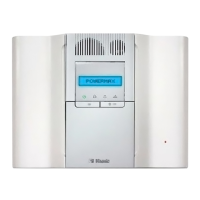
